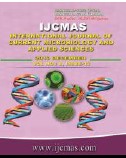


 National Academy of Agricultural Sciences (NAAS)
National Academy of Agricultural Sciences (NAAS)

|
PRINT ISSN : 2319-7692
Online ISSN : 2319-7706 Issues : 12 per year Publisher : Excellent Publishers Email : editorijcmas@gmail.com / submit@ijcmas.com Editor-in-chief: Dr.M.Prakash Index Copernicus ICV 2018: 95.39 NAAS RATING 2020: 5.38 |
A set of 52 leaf hopper resistant cotton accessions were evaluated in during Kharif 2017. Multivariate analysis employing Principal Component Analysis (PCA) identified seven principal components were accounted for a cumulative variation of 99%. The first principal component accounted for 70.5%, second for 12.16%, third for 6.6%, fourth for 3.75%,fifth for 2.94%, sixth for 2.39% and seventh for 1% of total variation. First principal component (PC 1) was correlated with boll shape (0.33) and bract size, petal color and boll surface, each of 0.20(Table 3). Second principal component (PC 2) was associated with boll shape (0.65) and bract size, petal color and boll surface, each of 0.24. PC 3 was correlated with leaf lobbing (0.95). Forth PC (PC 4) was associated with boll size (0.61) and leaf size (0.50). Fifth PC (PC 5) was related with leaf shape (0.60) and plant type (0.48). Sixth PC was related with plant type (0.35) and seventh PC correlated with stem hairiness, leaf size, bracts and petal color, each of 0.23. Principal Component Analysis (PCA) based on qualitative traits revealed that traits namely Bract size, petal color, boll shape and boll surface distinguished all genotypes in higher order than other traits. Convex of the hull occupied by the genotypes namely ICB124, H1464, Suvin, ICB 85, CSH3088, LHSusDCH32, and AKH1355 as these genotypes showed the highest point among the factors. All the genotypes were grouped into two distinguished clusters.
 |
 |
 |
 |
 |